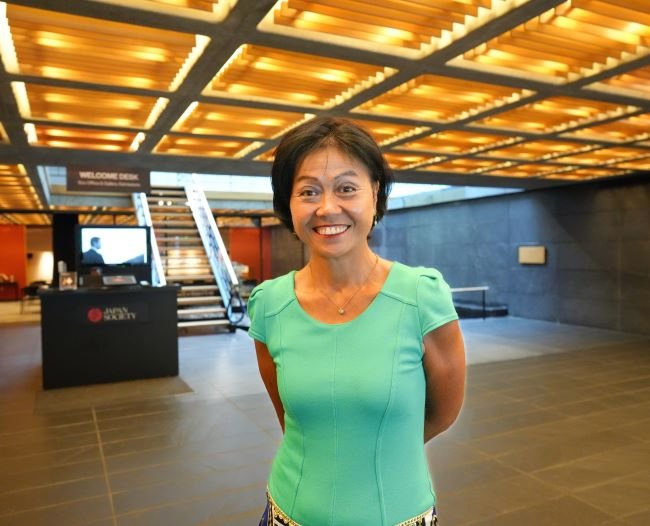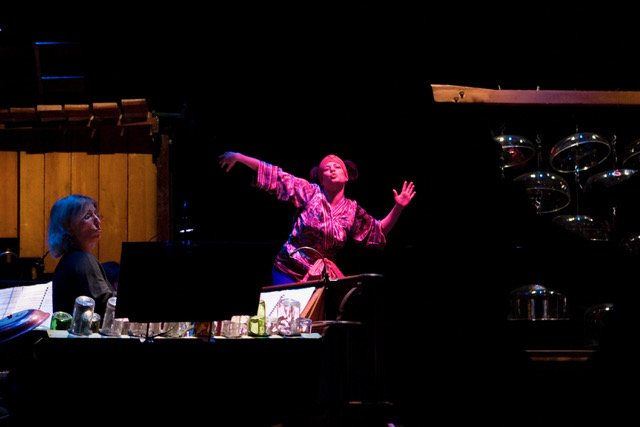YOKO SHIOYA discusses her 20 years as Artistic Director of the Japan Society, NYC
Yoko Shioya - photo courtesy of Japan Society
Catherine Tharin asks Yoko Shioya, Artistic Director of the Japan Society, NYC, about her 20 Years as Director of Programming
Tharin and Shioya met in Shioya’s office at Japan Society in January 2024. Ms Shioya discussed how her upbringing, her love of dance and opera, and her musical affinities influenced her approach to curation.
The delightful, upbeat, and charming Yoko Shioya, the winner of several awards, including a Bessie (New York Dance and Performance Award, 2020) for Outstanding Curation, is the first Japanese-born and native speaker hired by Japan Society to act as Artistic Director and Director of Performing Arts.
Shioya programs four performing arts genres: dance, music, theater, and traditional Japanese artistry. The season runs from September to June. As a native Japanese living outside Japan, Shioya is in a unique position to access Japanese performing arts communities close to those Japanese programmers living in Japan.
“We are looking for artists recognized for their artistic quality,” says Shioya. “We want artists highly acclaimed elsewhere but lesser known in America.” Light-hearted yet serious, Shioya expresses her exuberance with gesturing hands, a mobile face, and an infectious laugh.
Founded in 1907 by leading NYC business and professional men with ties to Japan and prominent Japanese citizens living in NYC, Japan Society endeavored to form close associations between the U.S. and Japan. This is still the case. Now in its second century, the Society commits to deepening mutual understanding between the United States and Japan in a global context.
John D. Rockefeller III served as president from 1952 – 1978. Under his leadership, soon after the end of WWII, Japan Society became re-engaged and expanded its outlook. Rockefeller’s wife, Blanchette, was responsible for hiring Junzō Yoshimura, one of the most important Japanese architects of the late 20th century, to design the Japan Society building. In 1971, Japan Society settled into its elegant late modernist building on East 47th Street, NYC, incorporating timeless Japanese architectural elements.
Photos courtesy of Japan Society
Catherine Tharin: Which curation makes you most proud over your 20 years as Director of Performing Arts, 2003-present, and Artistic Director, 2006-present, at Japan Society?
Yoko Shioya: Contemporary dance, experimental theater, and music concerts were happening before I came, but I expanded the scale of the programming in all areas. I also expanded the number of touring projects for the companies we have invited from Japan.
I produced opera from scratch. Producing opera is an interesting thing to me, given that both of my parents were amateur opera singers, and I was "forced" to accompany them on piano. My father played 19th-century Western opera recordings from early morning to nighttime every Sunday. The sound filled every room of the house and rattled the walls. I hated that, but now I am very proud to have brought new opera to Japan Society.
My first opera production was staging the composer Harry Partch’s experimental Delusion of the Fury from 1969, for Japan Society’s 100th anniversary in 2007. Partch’s work was rarely seen, and this opera hadn’t been mounted since its premiere. The instruments were handmade by Partch (to play his compositions specifically). Japanese theater and music were important influences on Partch.
Harry Partch, Delusion of the Fury (2007); Courtesy of Japan Society
Harry Partch, Delusion of the Fury, (2007), Harry Partch instruments; Courtesy of Japan Society
In 2017, our 110th Anniversary, we staged the chamber opera Four Nights of Dream, based on the great Japanese author Natsume Soseki’s short novel. The music by Moto Osada already existed, but I assembled a creative team, including Ken Masur as a conductor, Alec Duffy as a director, and Mimi Lien as a set designer, and auditioned to hire 6 singers. I involved Tokyo Bunka Kaikan, Japan's leading Western classical music venue, as a co-producer.
In 2023, I commissioned Pulitzer Prize-winning composer David Lang to create another new chamber opera from scratch. For this opera, note to a friend, I hired Yoshi Oida in Paris as a director. Producing a new opera is tough because you have to put together many different elements and specialists with my small teams.
But there is the great satisfaction of “Yes, we did that!” Those projects were really exciting. We're committed to commissioning for opera or whatever genres to create new productions and works. Our most successful collaboration was when we co-produced with a Japanese venue. There is then that bridge between Japan and the U.S., which is central to our mission.
In what ways does your curation differ from your predecessors?
Since Japan Society established the Performing Arts program in 1953, I was the first native Japanese person to become head of the program. That’s why I thought I should put more emphasis on my uniqueness, as my mother tongue is Japanese. I thought that more language-driven programming should be emphasized.
Before me, there were a lot of contemporary theater programs, but those works were recommended by some theater experts. I saw many theater productions in Japan by myself, and I could tell layers of meanings and the meaning behind the meaning. I could tell whether that work would resonate with American audiences. This kind of programming is more impactful in this city and through touring to other venues. We have produced and organized North American tours for contemporary experimental theater work from Japan every year until Covid.
In Japan, there is a rich culture of both traditional and contemporary performing arts. But no presenter or curator in Japan has familiarity with both traditional and contemporary. They are very separated communities. Traditional performing arts are performed by a small and contained group of artists; often, families practice one art form for generations. It has been a closed community but is slowly opening. The study of traditional arts became part of the educational system only two decades ago.
As a presenter, I am proud to have a deep familiarity with both traditional and contemporary performing arts. I graduated from Tokyo University of the Arts, which is like Japan’s Julliard, with BAs in musicology and art history. I went for Western musicology, but I had many friends whose major was the performance of traditional performing arts. I would skip classes to watch their masters in traditional arts perform. That attributed to my knowledge of traditional performing arts and my network in that community. Otherwise, it was not easy getting into that community.
Why are these communities so protective?
It’s partially feudalism. You are born in a certain family, but if you are out of the circle, not one of the family, let’s say, you would be in a "lower class" almost forever. If you’re talented here in the U.S., you climb up. In the Japanese traditional performing arts community, if you’re the master’s son, everyone is under you, even if the others are more talented.
What did you study at Tokyo University of the Arts?
I practiced piano since I was three years old. I added shamisen practicing in the university and studied dance history. Since I was little, dance is my heart. What I like most, my taste, I prefer dancers who have a dancer’s body and technique. I danced modern dance even before I was conscious of what I was doing.
When I was little, I contracted a very high fever. After this, the doctor told my mother I did too many things - painting, piano, and dancing. My mother chose the piano for me. I missed dance, but I pursued piano. When you grew up in Japan in those days, you felt it was too late if you didn’t dance from 4,5,6 years old.
When did you move to NYC?
My then-husband and I moved to NYC when we were young, in 1988. We had enough money to exist very simply for three years. I saw everything in the performing arts. This is the beginning of developing my taste. I studied dance. I went to Mary Anthony’s studio; all the classes were taught by her. She didn’t allow people to come and go. She said that if you must miss, you shouldn’t come long-term. Eventually, my work interfered with going to class. I don’t think I’m a good performer, but I like practicing dancing in the mirror. I think of myself as an athlete. I can’t express myself emotionally.
I also attended Anna Sokolow’s choreography class in 1988-89 at Mary Anthony’s studio. No experience was required. For those two years, I took her class, but I didn’t make any dance pieces of my own. I was there because I wanted to know how people made dances. An NYU student asked me to dance in her work. I said sure, and there were two or three others. When we practiced – even thinking of that I feel embarrassed – I was a bad guy character, and I was supposed to allure or trick a person. I was supposed to look the other dancer in the eye. But just looking at the person, I couldn’t do it. I’m perfectly fine making a speech for audiences of 300 or 3000. I’m not shy to expose myself talking in front of a group, but exposing myself artistically - no way.
In college, I practiced pantomime for four years with a private teacher who studied mime in France under Jean-Louis Barrault. There, I learned that you can use the body as an instrument - in the sense of musical instruments. For two years, dancers were in the class, and the class was very fun, but then the makeup of the class changed gradually, and theater people were prevalent. They were less about the body. They were more about their desire to have people look at them in a narrative play. I, too, liked to check my body in the mirror because mime is a very precise expression. However, facial expression, though the face is part of the body, is a different matter to me, especially when you have to convey a narrative story. Theater people in that studio wanted to create their narrative play more and more. The teacher was pleased with that eagerness, but I didn't want to do that. I was, and I am, more in tune with dancers for this reason.
CATHERINE THARIN choreographs, curates, teaches, and writes. She danced in the Erick Hawkins Dance Company in the 1980s and '90s, was the Dance and Performance Curator at 92NY, NYC, for 15 years, and was a senior adjunct professor at Iona College, New Rochelle, NY, for 20 years. She writes dance reviews for The Dance Enthusiast and The Boston Globe, articles about dance for Side of Culture, and reports on dance for WAMC/Northeast Public Radio. She curated a 2024 dance season at Stissing Center, Pine Plains, NY. She continues to teach the Hawkins philosophy, technique, and repertory as an artist-in-residence. Her latest dance is a collaboration with jazz composer Joel Forrester and filmmaker Lora Robertson. Says Fjord Magazine of her work presented in November 2023: "gentle and precise movement contained to a small range, a good deal of floor work...cast a net of whimsical translucent sheen over it all. The evening was consistently charming, well-crafted and paced."










